Whatever your reasons are for growing sunflowers, be it for the kids to see if they can grow the tallest or biggest blooms. Collecting sunflower seeds for roasting. Growing golden yellow or pink sunflowers for wedding bouquets. Gifting bunches of lovely pollen-free blooms to a friend who has allergies. For feeding wildlife or pet food. And for sunflower companion planting, there are over 70 varieties out there to choose from.
Yes, Over 70!? Sunflowers…for all occasions, arrangements, and situations. For pots, bedding
It’s a helpful guide full of descriptions, color, and very handy height charts to take out the mystery of how tall or small a sunflower looks visually. Choose your sunflowers and meet me back here, then use all these helpful tips on how to grow sunflowers with success. It opens in a separate page and you just have to click back so you don’t lose me.
How to grow wonderful sunflowers. The best tips for giving sunflowers the best start to their growing season. From cleaning seed trays, choosing the right variety of sunflower and how to pick the healthiest seeds. When to sow, where and how to prepare their growing site. How much water they need. And so much more. It’s all here
These tips will help towards getting the most out of your sunflower season. Whether you’ve got one pot on your doorstep or balcony, troughs, window containers, a patch in your yard or you’re lucky enough to have a field to fill with the blooming lovelies.
Table of Contents
Sunflower Growing Conditions
Generally, sunflowers are quite easy to grow. But depending on your climate, growing conditions and how you look after them, your sunflowers can vary from your yard to that of your neighbors. It’s still a big learning curve for me. I’m always surprised at what works and what sunflowers need more help than others. Here are some great tips I use that give my sunflowers the best advantages to grow year after year.
Growing sunflowers is a pleasure indeed,
So here are my top tips for you to succeed,
Grow the tallest, or the smallest and the very best blooms
Pamela-Anne
How Much Sun Do Sunflowers Need
In ideal conditions, sunflowers need a lot of sun. So try and pick the sunniest area that you can grow them in, whether they’re in pots or in the ground.
- Full sunshine is ideal. Having 6 to 8 hours of sun during the day will optimize the sunflower growing to its utmost.
- Dappled shade is ok, but your sunflower might not get the height and as big a bloom as it can. Also, your sunflower might crane, get leggy or droop. I have this trouble too, so I’ve written a more detailed article on how to help with this problem here.
- If your yard has the problem of being mostly in the shade, you could choose sunflowers that thrive better for your conditions. If you can’t find any locally, have a look through my guide here.
Preparing Your Sunflower Growing Site
You’ve decided on the area your beautiful blooms are to spend their summer, now comes some hard work. Digging over the site. There are a few digging techniques used in gardening, but generally, sunflowers will thrive well in a single, one shovel/spade deep dig…”phew” I hear you say. Wait I’ve not finished. Here are my tips.
- Dig the area at least one month before planting your sunflowers. This gives the turned soil time to weather and breaks down clumpy lumps of soil.
- Dig the area at least one shovel deep, like the picture below. If you have the depth and energy, two shovels deep would be even better.
- Make sure the soil is not clumpy. So rain and water will drain. Use the back of your shovel to whack the lumpy soil till it’s broken up. Then use a rake to smooth the crumbled soil over your growing area.
- This stage of digging is a good time to mix in any food compost or leafy mulchy materials. This gives it a good length of time to break down and disperse evenly.
- Keep the area weed free. This will stop the weeds from sapping all the food source and clogging up the soil with unwanted root systems.

How to Support Your Growing Sunflowers
Sometimes Even the strongest of sunflowers need staking. if you’re in a competition to grow the tallest or biggest bloom, you may need to help your prize sunflowers with a bit of support.
I too have been caught out with sudden summer storms. My family finds it comical to see me outside battling against 40mph winds and heavy rain, wrestling my 8 foot high sunflowers trying to get them propped back up again. So if you know your sunflower is a variety that grows tall, my first tip is
- Use strong stakes, bamboo canes or poles that are strong and have a good diameter. Length and strength are of the essence.
- Get your supports up before your sunflowers grow too tall or the weather hinders the building process.
- Build your support system before planting out your sunflower seedlings. Pushing stakes into the ground will loosen the soil and may damage their roots.
- Make sure the stake is malleted 12 inches or more into the ground. Hopefully, This will ensure a sturdiness against any sudden weather changes
TOP TIP: When it’s time to start tying your sunflowers to their stakes, use a non-abrasive string or cord. Don’t tie them too tight, leave room for the stem to grow thicker and for the sunflower to sway and follow the sun.
Selecting Your Sunflower Seeds
You’ve chosen your sunflower seeds and like me, you’re full of anticipation. It’s so exciting finding the sunflowers you want and hope they’ll grow up to be as gorgeous as the image on the packet. So to give them the best start in life here are my first tips for your sunflower seeds.
- Make sure your seeds are of good quality, bought from a good source or have been stored in an airtight, clean container.
- Look through your seeds and pick the ones that look the healthiest. This may sound obvious but split, damaged or powdery diseased seeds, may contaminate others they’re planted with.
- Always keep unused seeds in a dry place. Reseal the packet or put in an airtight container with the seed packet, or written information for future reference.
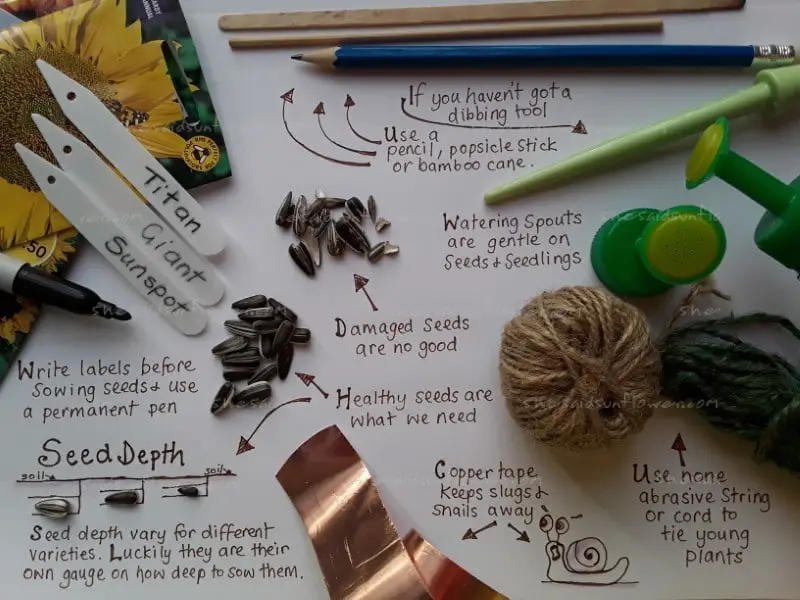
Labeling Your Sunflowers
I’ve been guilty of not doing this myself, by accident or overconfidence. Labeling is so important. Whether you have one sunflower variety or several. It’s easy to forget but is a good habit to form and will serve you well in so many ways. Whether you need information on the seeds you’ve planted for yourself, or gifting seedlings and want to give care instructions to their new owners.
- Get your pens and labels ready to write on before you sow your seeds. Even better…
- Get your labels written, and placed with their corresponding seed packet before you start sowing.
- Use durable labels. Most hard, white plastic labels are easy to write on, easy to spot against the soil, are reusable from indoors to outside and can be used year after year. Wooden and metal labels are adequate too, but tend to rot down, rust and have to be replaced more often.
- Use an indelible ink pen or marker to write on your labels. This ink won’t fade in the sun. Use wire wool, or a scouring pad to rub off any mistakes or to rename last seasons sunflower labels.
- If you’re sowing seeds indoors or outside, remember to stick the label in at the end of each row, pot or seed tray as you’ve planted it.
When to Sow Sunflower Seeds
Now you’ve decided on your variety of sunflowers, and where your final planting site or pot will be, Let’s talk about the weather.
- Check on the back of the seed packet as to what time of year you can plant your seeds. This varies from region to region but…
- If you’ve been given your seeds or haven’t the packet, then here’s a very basic and general guideline of indoor, outdoor sowing, and planting out times in your hemisphere.
I’ve drawn a visual guide below for both hemispheres showing when to sow indoors and outdoors, when to plant and when to harvest sunflowers for your region.

How Deep to Plant Sunflower Seeds
Different sunflower seeds vary in size, so the packets they come in give a growing depth for each variety. However, if you’ve been given your seeds or have no instructions, here’s my big top tip for sowing any sunflower seed, be it inside or outside, in a pot, or straight into its growing site.
TOP TIP: Basically, and amazingly each seed is a guide to its own growing instruction. Just cover the seed with its own depth of compost on top. Sorted.

Sowing Sunflowers in Pots and Trays Indoors
You can start Sowing your sunflower seeds inside your home, or greenhouse from the beginning to middle of spring. If you haven’t got your seed packet with the information guide of when to sow and plant, take a look at the global guide I’ve drawn above. It’s only a general guide but I hope it helps.
- Clean all the pots, seed trays, labels, and any tools you intend to use in warm mild detergent water. This will stop any spores or pollutants from contaminating your new seeds. Even if they’re new pots and seed trays, wash them, as they may contain unwanted manufacturing materials and chemicals.
- Make sure all your pots, tubs and trays have good drainage. Put holes in the bottom of containers that need them. This will allow the water to drain out so your seeds or seedlings won’t be sitting in a pool of water. Sitting in water will rot them.
- Use fresh all-purpose or seed compost. Using old compost or garden soil might be full of fungus, weed seeds and uninvited beasties. If you’re growing seeds and plants inside your home, this a must.
- Put planted seeds in a well lit and warm area. This will give them the best chance of germination. Even sunny window sills in warm rooms are enough to start most seeds growing.
TOP TIP: Even if you only have a few sunflower seeds and one pot. All you need is a bright window sill. Keep them warm and watered and watch them grow.
Growing Sunflowers in Pots Outdoors, and in the Ground
If you’ve not got your ground or pots ready for planting, then use the tips above for ‘Preparing Your Sunflower Growing Site’. If you’ve got everything prepared that’s great, and here are my next tips.
- Make sure outdoor pots and containers are freshly cleaned and cleared of any debris from last years planting. Contaminants can hinder your sunflower seeds or seedlings growth.
- Sow 2 or 3 seeds close together. This gives a better chance of getting a crop. If all of them are successful that’s fantastic. Thin out the weakest and plant them elsewhere, or gift them over the fence to other sunflower lovers.
- Always label your sunflower varieties as you sow. That information will give you a better chance to look after their individual needs.
- Water your freshly planted sunflower seeds gently, so as not to wash away the soil on top of them. Use a perforated spout (or rose) on your watering can, or a fine sprinkle attachment on your garden hose.
- Take steps to keep natural garden predators at bay, and little can go wrong. Use netting to deter flying, feathered friends. Copper strips, crumpled eggshells or coarse grit to keep snails, slugs and ground beasties at bay. These are safer on the environment and ‘wont cost the earth’. On so many levels.
If you choose to use chemicals I have found some environmentally safe ones that won’t harm wildlife, pets or humans. If you can’t find them locally I have them here for you from Amazon
Watering Sunflowers
Once you’ve planted your seeds, inside or out, they’ll need watering. I’ve written a more detailed article on how much water a sunflower needs here. But here are my quick tips
- On newly planted seeds use a gentle watering rose or sprinkler. This is so you don’t wash away the soil or displace the seeds.
- Make sure you have good drainage for all your sunflowers and seeds growing in the ground or in pots. This will ensure that seeds, seedlings, and mature sunflowers aren’t standing in water that will cause them to decay.
- It’s best not to let your seeds or seedlings dry out. This will stop the germination process. Water daily while they are germinating and establishing themselves
- If your soil is poor quality, give your sunflowers shoots a weekly fertilizer in their young growing stage. Stop using fertilizer for mature plants, so the buds and blooms can grow. If you keep feeding sunflowers all their energy will go towards leaf growth. This will hinder bud and bloom development.
TOP TIP: I use These small sprinklers tops to control the force and flow of the water on my seeds and tender seedlings. If you want to try these and can’t get them locally, I’ve found the same type I use on Amazon in a set of 12, or singularly.
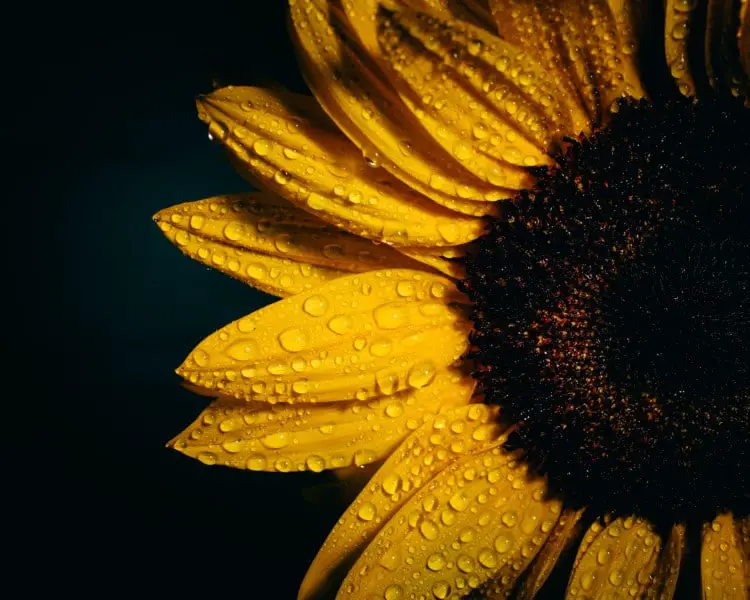
Thinning out Sunflower Seedlings
Pricking out is a term used when talking about seedlings that are rapidly popping through the soil, and are all bunched up together. Whether you planted seeds in their growing site or a few at a time in seed trays or pots. The time comes to separate them and leave the strongest in situ for growing on.
Personally, I try to take the time and make the effort to ease the little baby sunflowers out of their crowds and pot them up. If I have an abundance of them I leave them labeled up as gifts on my neighbors’ doorsteps. Within a few months, I see them from afar, fully grown and bobbing about in the sun. it’s such a pleasure giving them a second chance. Waste not, want not.
- Prepare clean pots, written labels, moistened compost with planting holes in advance. It’s so much easier to get all these things prepared beforehand rather than when your hands are mucky with soil.
- Wait till you have two or more true sets of leaves that are large enough to handle when thinning out sunflower seedlings.
- Choose the strong stemmed seedlings to thin out and pot on.
- Gently hold a true leaf between your thumb and finger, then with care, use a dibbing tool, pencil or pen to ease the young sunflowers up, and away from the rest of the seedlings. Place the roots in the planting hole and carefully push the soil around the stem.
Hardening Off Sunflower Seedlings
Hardening off basically means getting your soft, tender sunflower seedlings acclimatized for the outside world. They’re still precious at this stage, so be careful with them. Hardening off usually takes a few weeks before they’re ready to be planted in their growing sites or pots.
- Put pots of seedlings on trays so you can move them around more easily. This Lessens the chance of spillage. This makes it easier and quicker to bring them in and out for their hardening off period.
- Brush the seedlings gently with your hand. Do this often to strengthen the stems for wind resistance. This movement activates the growth hormone and makes the stems stronger.
- Place the sunflower seedlings outside in a warm spot during the day and always bring in at night. Don’t leave them out at night in case there’s a frost.
- After a week or two, and if the weather’s fine, leave then outside at night against a sheltered wall.
- If the weather takes a sudden turn for the worse. Protect them from it by temporarily covering with a fine garden fleece, or bringing them inside short term.
Transplanting Sunflowers
Transplanting means that the sunflowers you’ve hardened off can now be planted outside in their growing site, or containers. This will be their new home for the season.
- Make sure all fear of frost has gone.
- Choose an area that gets the most sunshine during the day. If your growing site is dappled or shady please don’t let this stop you from growing sunflowers. just be prepared that they may not grow as much, or give a huge yield of seeds.
- Spacing out varies for different varieties of sunflowers. Check the back of your seed packet To give them the room they need to grow.
- For the first few weeks make sure to protect your succulent seedlings from local wildlife. Pots or bedding can be draped with netting.
- Always label sunflower seedlings when you’ve planted them, so you can give them care for their individual needs. And it helps to know what’s what if you keep a growing journal.
Protecting Sunflowers from Bugs and Critters
I might be in a minority here but I enjoy all the wildlife, critters, bugs, butterflies, bees and birds that my sunflowers attract every year. And I’ve written all about this delightful topic here. I also companion plant my sunflowers with vegetables, salads, herbs and other flowers to encourage pollination.
Having said that, I do appreciate that our prize sunflower blooms, and in particular the ones I’m growing for a purpose, such as wedding bouquets or for seed harvest, can get more attention than they should. So here are my tips for lessening the whole of the neighborhoods wildlife population, in its many glorious forms, feasting and munching on my scrumptious sunflowers.
- Get nature on your side. Place bird and wildlife feeders elsewhere in your garden to lure them away from your yummy sunflowers.
- Attract Friendly bugs into your garden by planting companion plants such as herbs, vegetables, salad, and other flowers. Your mini echo system will then look after itself.
- For large infestations of black fly or aphids, try putting a small amount of mild detergent diluted with lots of water in a bucket then, with a sponge gently wash the problem area.
- When growing sunflowers to harvest the seeds, put a net over the seeding blooms, or grow them under a fruit netting cage, which
i thin are awsome. This helps to stop the bigger critters and flying friends having a free lunch.
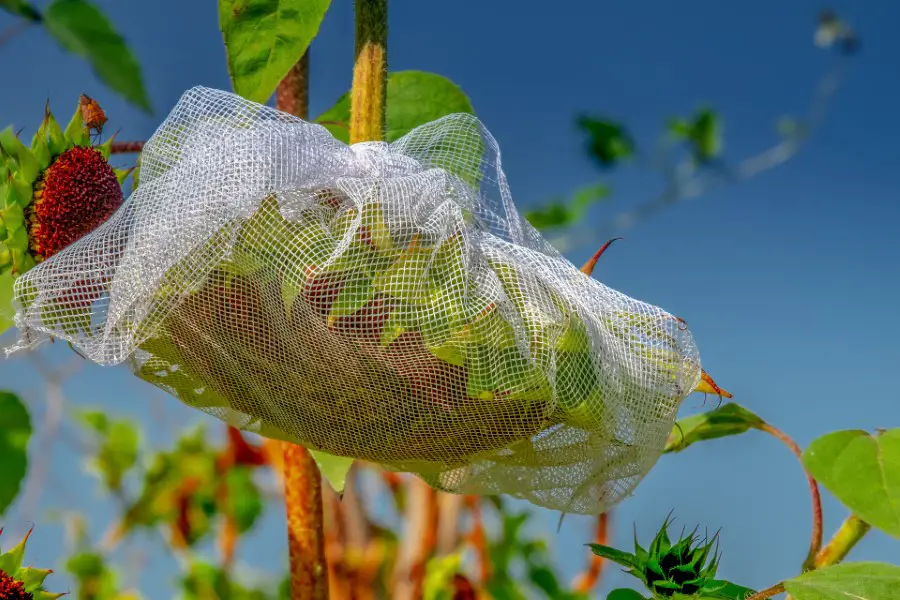
TOP TIP: There are a number of store-bought garden and yard deterrents that are friendly to the environment. If you have trouble finding anything locally, I’ve found a variety of natural deterrents for different pesty problems in my resources pages.
Ongoing Care for Sunflowers
I love my garden. It’s such a pleasure growing my sunflowers and so much more. But I’ll be the first admit that it takes a lot of time and effort to keep up with the problems, and challenges that go with it. So here’s how I to keep on top of things.
- Take Regular inspections around all of your yard or garden. Take notes and…
- Sort out any minor problems you find before they become a major problem.
- Take notes and photos of any kind of success and failures. This will help solve future problems, and remind you what you liked and disliked from your last growing seasons.
Last and Best Top Tip. Enjoy your Sunflowers 🙂
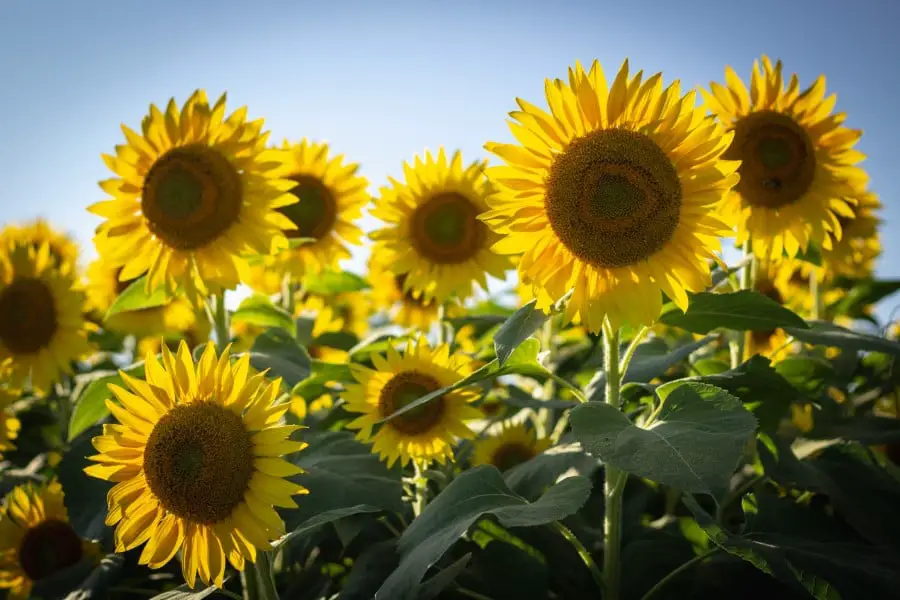
My Final Thoughts
If you are a new gardener or have been gardening forever, I hope, amongst the tips I’ve given, a few will help you grow sunflowers with great success this year. Growing sunflowers presents so many wonderful, and sometimes precarious challenges to me.
I try to stay on top of things in my garden to minimize problems. And my goal of keeping nature on my side by nurturing it, rather than hindering it plays a big part in my life. And finally, as one sunflower grower to another, I hope you grow the most amazing sunflowers this season and every season hereafter.
There are many tips I’ve yet to learn, so If you have any you’ve found that are helpful, and would like to share, please feel free to write them in the comments below. They will be gratefully received. Thank you.
Related Questions
How long does it take to grow a sunflower? From when an annual sunflower seed has been sown, to it being in full bloom, can take approximately 120- 180 days (17-26 weeks). This also depends on the variety, weather conditions and care thats given. If you’d like to know more about the growth timeline, and life cycle of sunflowers, I’ve written much more detail about this captivating subject here
Do sunflowers come back year after year?There are a few sunflowers that come back each year. These are perennial varieties that are usually smaller plants and has smaller and multiple blooms too. The giant, tall iconic sunflowers, are generally annual plants. This means they only last for one growing season.

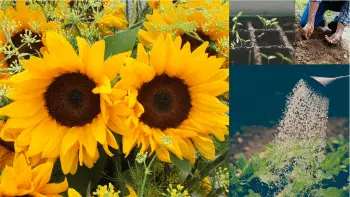
Pamela-Anne,
I absolutely love your website! It’s surprising to me how iconic sunflowers are and yet what sparse information is out there about them.
Quick question. My father loves to be thrifty and wishes to feed our local birds and enjoy some simple gardening at the same time. He wishes to plant the seeds of the black oil sunflower plant, which are used in local feed stores as bird feed.
What does the plant actually look like? How tall does it get? Is it multi-stem, single stem? Multi-bloom per stem? Etc.
Photos I find on the internet are pretty inconsistent, and also often so the plants so tightly packed together it’s hard to tell where one plant begins and another one ends.
I was hoping to see the plant on your beautiful illustrated charts, but alas no black oil sunflower plant.
Thanks again for all the sunflower info! I’m a fan of sunflowers!
thank you Veronica for your lovely comment. Sunflowers are easy and enjoyable to grow. And the first sunflower I ever grew (aged 8) was from a seed picked out of the dried seed mix of our guinea pigs food, and I’ve been growing sunflowers ever since :). So, if your father already has some sunflower seeds he feeds the birds with (with the shells on) try planting some of those first. Often these seeds are a variety called Peredovik. They grow 4-5 feet tall and have a single yellow, medium-sized bloom (approximately 6-8 inches in diameter). If you haven’t a yard, they’ll be happy in large pots, with a support stake. If your father would prefer to grow them from a store-bought packet, and you can’t find them locally, I’ve found them for you. This packet contains approximately 40-50 seeds. Click on the name, and it’ll take you to them. Peredovik Black Oil Sunflower. I hope I’ve been of help. Good look with growing these sunflowers and feeding the birds. x